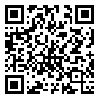Volume 11 - Articles-1400
MEJDS (2021) 11: 143 |
Back to browse issues page
Download citation:
BibTeX | RIS | EndNote | Medlars | ProCite | Reference Manager | RefWorks
Send citation to:



BibTeX | RIS | EndNote | Medlars | ProCite | Reference Manager | RefWorks
Send citation to:
Ghorbanzadeh M, Hafezi F, Pasha G, Ehteshamzadeh P. The Effects of Acceptance and Commitment Therapy on the Fusion of Thought-Action and Self-Related Harmful Behavior in Substance Dependents. MEJDS 2021; 11 :143-143
URL: http://jdisabilstud.org/article-1-1672-en.html
URL: http://jdisabilstud.org/article-1-1672-en.html
1- Ahwaz Branch, Islamic Azad University
Abstract: (2318 Views)
Background & Objectives: Substance dependence is a significant issue in society and among the most widespread health risk factors examined from the biopsychosocial perspective. Among the consequences of substance use can be the intermingling of thought–action, i.e., the desire and tendency of the individual to combine thoughts and actions. Accordingly, these individuals may become confused with their thoughts. These thoughts are intrusive, unintentional, unpleasant, uncontrollable, and meaningless; thus, they might harm themselves or others. The third–wave cognitive–behavioral therapies can effectively rehabilitate substance–dependent individuals with an emphasis on awareness and attention to psychological resilience. Among these interventions are Acceptance and Commitment Therapy (ACT). Thus, the present study aimed to evaluate the effects of ACT on the interplay of thought–action and self–harm in substance dependents.
Methods: This was a quasi–experimental study with a pretest–posttest and a control group design. The study's statistical population consisted of all substance dependents referring to Substance abuse treatment centers in Sari City, Iran (N=1700). The study population was vast; it was impossible to compile a list of all community members. Therefore, sample selection was challenging from an administrative point of view. Therefore, simple random sampling and inclusion criteria were used to select the sample. Initially, centers with more experience, cooperation, and diversity in substance–dependent clients were identified (N=10). Then, 6 centers were selected by simple random sampling. The Thought–Action Fusion Questionnaire (TAFQ; Shafren et al., 1996) and The Self–Harm Inventory (SHI; Sanson et al., 1998) were distributed. Thirty individuals from these centers who met the inclusion criteria to enter the research and receive scores greater than 38 from the TAFQ and scores greater than 5 from the SHI were selected as a sample and divided into two experimental and control groups (n=15/group). The inclusion criteria of the study were at least a 5–year history of substance dependence; referring to drug abuse treatment centers in Sari; ages between 25 and 40 years; consent to participate in the research; ability to attend treatment sessions; no acute mental illness, and not attending other interventions, concurrently. Exclusion criteria included absence from more than one ACT session, not participating in the research, and not completing the questionnaire. ACT (Hayes & Strosahl, 2004) was administered to the experimental group in 8 sessions. The obtained data were analyzed using descriptive statistics (mean & SD) and inferential statistics, including Multivariate Analysis of Covariance (MANCOVA) in SPSS at a significant level of 0.05.
Results: The obtained results suggested that after removing the pretest effect, ACT was effective on thought–action fusion and its components, including ethical thought–action fusion, probabilistic thought–action fusion for others, and probabilistic thought–action fusion for self (p<0.001). Moreover, ACT effectively declined self–harm behavior in the experiment group (p<0.001).
Conclusion: ACT effectively reduces thought–action fusion and self–harm behavior in substance dependents. Thus, it is suggested to improve the fusion of thought–action and self–harm behavior in this population.
Methods: This was a quasi–experimental study with a pretest–posttest and a control group design. The study's statistical population consisted of all substance dependents referring to Substance abuse treatment centers in Sari City, Iran (N=1700). The study population was vast; it was impossible to compile a list of all community members. Therefore, sample selection was challenging from an administrative point of view. Therefore, simple random sampling and inclusion criteria were used to select the sample. Initially, centers with more experience, cooperation, and diversity in substance–dependent clients were identified (N=10). Then, 6 centers were selected by simple random sampling. The Thought–Action Fusion Questionnaire (TAFQ; Shafren et al., 1996) and The Self–Harm Inventory (SHI; Sanson et al., 1998) were distributed. Thirty individuals from these centers who met the inclusion criteria to enter the research and receive scores greater than 38 from the TAFQ and scores greater than 5 from the SHI were selected as a sample and divided into two experimental and control groups (n=15/group). The inclusion criteria of the study were at least a 5–year history of substance dependence; referring to drug abuse treatment centers in Sari; ages between 25 and 40 years; consent to participate in the research; ability to attend treatment sessions; no acute mental illness, and not attending other interventions, concurrently. Exclusion criteria included absence from more than one ACT session, not participating in the research, and not completing the questionnaire. ACT (Hayes & Strosahl, 2004) was administered to the experimental group in 8 sessions. The obtained data were analyzed using descriptive statistics (mean & SD) and inferential statistics, including Multivariate Analysis of Covariance (MANCOVA) in SPSS at a significant level of 0.05.
Results: The obtained results suggested that after removing the pretest effect, ACT was effective on thought–action fusion and its components, including ethical thought–action fusion, probabilistic thought–action fusion for others, and probabilistic thought–action fusion for self (p<0.001). Moreover, ACT effectively declined self–harm behavior in the experiment group (p<0.001).
Conclusion: ACT effectively reduces thought–action fusion and self–harm behavior in substance dependents. Thus, it is suggested to improve the fusion of thought–action and self–harm behavior in this population.
Keywords: Acceptance and Commitment Therapy (ACT), Thought–Action fusion, Self–Harm behavior, Substance dependents.
Type of Study: Original Research Article |
Subject:
Psychology
Send email to the article author
| Rights and permissions | |
 |
This work is licensed under a Creative Commons Attribution-NonCommercial 4.0 International License. |





